Art in London and Paris 2019
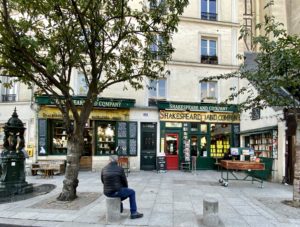
Left Bank
I prefer to travel during the saddle periods, when tourists have thinned and the weather is acceptable. I spent two weeks in London with a week in Paris sandwiched in between, mainly to spend time with old friends, but also to quench my thirst for world-class art and theater.
Both cities are international metropolises with people from all over the world, often speaking languages that are not English or French. This melding of cultures enriches them, but makes nativists anxious. The irony of looking back to their supposedly glorious past, when their ancestors plonked themselves and their culture by force in many countries, doesn’t resonate. In London, the Brexit debate was aflame, and political maneuvering took many twists and turns during my stay. In contrast, Paris was politically calm.
Walking

Cruise on Seine
Although public transport is excellent in both cities, I chose to walk most of the time to enjoy the ambience and the architecture, especially in Paris. As it boasts building design styles from 1,000 CE to modern times, strolling, stopping to gaze at their magnificence, is a delightful way to get from one place to another. My apartment was near Jardin Luxembourg, the Pantheon, and Bibliotheque Genvieve, a university area with countless restaurants, cafes and bars, and supermarkets. Walking along Blvds St. Michel and St. Germain, down Rue Seine to the river brought back memories of my youth when I visited often from London where I was a student. Continuing along the Left Bank are the Rodin, Quai d’Orsay, and Quai d’Branly museums, and across the river on the Right Bank are the Grand and Petit Palais, L’Orangerie, Jeu de Paume, the Tuileries gardens and the Louvre. Rue Seine in particular, but many other streets as well, are lined with art and culture galleries (paintings, lithographs, old books, antiques, and more). I know of no other city that has as much art as Paris.
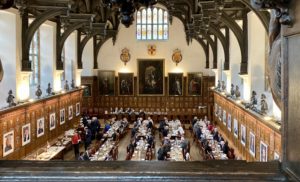
Middle Temple Dining Hall
By comparison, London is austere, with more modern buildings among the old structures, but still enjoyable to walk along the main thoroughfares with museums and galleries as my destinations. I also visited the London School of Economics, my alma mater, to register as an alumnus and get a library card. From a small college during my time, it now has 12.000 students, more than half are graduate students and around 70 percent are “overseas” students. The college has expanded to take over the most of the adjoining space and several buildings around Lincoln’s Inn Fields.

Royal Courts
I was lucky to have lunch at Middle Temple Hall, a huge dining room with paintings of eminent alumni hung on wood paneled walls topped by enormous windows. It was the headquarters of the Knights Templar and is one of the four inns or court where lawyers are trained. A Templar church adjoins Middle and Inner Temples with lawyers’ offices surrounding them as the Royal Courts are just across the street. Later, I got a tour of the Supreme Court, a relatively newer building modernized inside with two court rooms and a third room for the Privy Council to hear cases from some former colonies.
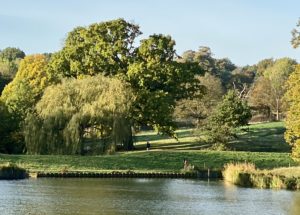
Hampstead Heath
Most of all, I enjoyed daily walks on Hampstead Heath, with ponds on both ends lined with trees and shrubs, some showing fall colors, Kenwood House, a stately mansion at one end, and church spires and modern skyscrapers in the distance. It’s an old haunt that I still love because of its country feel right next to a village that is in the middle of a metropolis.
Museums and Art Galleries
Although I am grateful for chance to view so much art in both cities, I would have preferred more time in between visits to galleries to fully appreciate what I was seeing. Done so quickly, there wasn’t enough time for one masterpiece to sink in before another blurred it.
London
 The British Library had an exhibit on Buddhism. Upon entering, the sound of chanting and flowing water had a calming effect. Panels told the story of Buddha’s journey and teaching. Disappointingly, the myth that he was a prince was repeated. In fact, he was the son of a senator in a republic. Still, the story of Buddhist philosophy and its spread through Asia told through colorful religious objects and scrolls kept me absorbed.
The British Library had an exhibit on Buddhism. Upon entering, the sound of chanting and flowing water had a calming effect. Panels told the story of Buddha’s journey and teaching. Disappointingly, the myth that he was a prince was repeated. In fact, he was the son of a senator in a republic. Still, the story of Buddhist philosophy and its spread through Asia told through colorful religious objects and scrolls kept me absorbed.
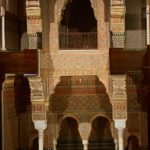 The Islamic Art Exhibition at the British Museum, in collaboration with the Islamic Art Museum of Malaysia, traces the origins of Orientalism back to the 15th Century to show its enduring influence on Western painting, architecture, glass, jewelry and other material objects. The term Orientalism is charged, as some of the art shows a stereotyped view of the Middle-East, and can be seen as patronizing. Nevertheless, some pieces, such as the portrait of Sultan Bayezid I, were striking.
The Islamic Art Exhibition at the British Museum, in collaboration with the Islamic Art Museum of Malaysia, traces the origins of Orientalism back to the 15th Century to show its enduring influence on Western painting, architecture, glass, jewelry and other material objects. The term Orientalism is charged, as some of the art shows a stereotyped view of the Middle-East, and can be seen as patronizing. Nevertheless, some pieces, such as the portrait of Sultan Bayezid I, were striking.
 Kara Walker’s huge fountain, Fons Americanus, is the annual commission for the cavernous Turbine Hall at the Tate Modern. Although it apparently looks like the Victoria Memorial fountain, which has figures glorifying progress, Walker’s figures allude to slavery and resistance, the darker side of empire. A walk through the museum’s collection, especially the Rothko room, was a reminder of how brilliant and imaginative abstract painting can be.
Kara Walker’s huge fountain, Fons Americanus, is the annual commission for the cavernous Turbine Hall at the Tate Modern. Although it apparently looks like the Victoria Memorial fountain, which has figures glorifying progress, Walker’s figures allude to slavery and resistance, the darker side of empire. A walk through the museum’s collection, especially the Rothko room, was a reminder of how brilliant and imaginative abstract painting can be.

Reviewers panned the National Gallery’s exhibit of Gauguin’s portraits as a timid cop out because it did not include many of his paintings of nude Tahitian women, but I enjoyed the warm colors and expressions in that series anyway. His more austere work from Arles, where he lived with Van Gogh, was less attractive.
 Although I share Vipassana meditation practice with Anthony Gormley, which helps to see things as they are, I was unable to see his vision for many of the sculptures on display at the Royal Academy. I understood the tiny iron baby in the large courtyard that is in need of comfort and sustenance, but also has destructive potential; I sort of got matrix III, a huge room of steel bars that are 21 large intersecting cages with a void core, symbolizing a room for thinking within an expanding universe; I did not get “fruits of the earth” as a loaded revolver, a machete and a bottle of wine with edges softened to look like organic forms.
Although I share Vipassana meditation practice with Anthony Gormley, which helps to see things as they are, I was unable to see his vision for many of the sculptures on display at the Royal Academy. I understood the tiny iron baby in the large courtyard that is in need of comfort and sustenance, but also has destructive potential; I sort of got matrix III, a huge room of steel bars that are 21 large intersecting cages with a void core, symbolizing a room for thinking within an expanding universe; I did not get “fruits of the earth” as a loaded revolver, a machete and a bottle of wine with edges softened to look like organic forms.
Never having seen William Blake’s work, the exhibit at Tate Britain of 300 etchings and paintings was overwhelming. A complex person and a free spirit, he was against science and the Age of Reason, but also against the establishment, slavery and organized religion. His work is open to many interpretations. His engravings are meticulous and imaginative, and perhaps contradictory, with scenes of religious symbolism, or set in outer space, or in the ocean. One looks like the statue of liberty, which could have influenced the architect of that monument.
 The Dulwich Picture Gallery’s exhibit of 35 Rembrandt etchings and paintings showing his use of light was worth the train and bus ride. The lighting arrangement by a cinematographer brought radiance to the faces and warmth and luminescence to the clothes. The permanent collection included a few works by Gainsborough, Constable and Peter Paul Rubens.
The Dulwich Picture Gallery’s exhibit of 35 Rembrandt etchings and paintings showing his use of light was worth the train and bus ride. The lighting arrangement by a cinematographer brought radiance to the faces and warmth and luminescence to the clothes. The permanent collection included a few works by Gainsborough, Constable and Peter Paul Rubens.
Paris
The renovated Rodin Museum is a pleasure to visit, especially as he is my favorite sculptor. Two of his most renowned works are in the front garden, the Gates of Hell to the left and The Thinker to the right, but the former includes a small version of the latter at the top as well. I spent a long time gazing at these statues and walking around the rear garden too. Rooms inside the mansion displayed many of his other works, including The Kiss, and his personal collection of paintings by such luminaries as van Gogh, Renoir and Monet. The café in the rear garden is well situated but serves mediocre food.
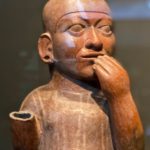 Whatever one’s political views about the “western gaze” on non-western art, or more accurately pre-modern global art, Musee Quai d’Branly has a well-displayed collection of objects from Oceania, Asia, Africa and the Americas. The walk-through flows from one region to the next with special pieces in alcoves. The influence of some of this art on western artists such Picasso and Giacometti is obvious. The architecture of the museum is remarkable, a tower that lets in shaded light, set on stilts and surrounded by a garden with the Seine flowing nearby.
Whatever one’s political views about the “western gaze” on non-western art, or more accurately pre-modern global art, Musee Quai d’Branly has a well-displayed collection of objects from Oceania, Asia, Africa and the Americas. The walk-through flows from one region to the next with special pieces in alcoves. The influence of some of this art on western artists such Picasso and Giacometti is obvious. The architecture of the museum is remarkable, a tower that lets in shaded light, set on stilts and surrounded by a garden with the Seine flowing nearby.
 I visited two exhibitions at the Grand Palais. The Toulouse-Lautrec exhibit showed 200 of his paintings, posters, drawings, lithographs and some letter exchanges with Degas and Manet as well. His representations of the Moulin Rouge dancers and loungers were as alluring as ever, captured the movement and mood of the cabaret brilliantly. The International Contemporary Art Fair (FIAC) boasted 199 galleries from 29 countries. I was overwhelmed by the amount of art on display, lingered at a few paintings that caught my eye, especially an abstract by Corbusier, the architect.
I visited two exhibitions at the Grand Palais. The Toulouse-Lautrec exhibit showed 200 of his paintings, posters, drawings, lithographs and some letter exchanges with Degas and Manet as well. His representations of the Moulin Rouge dancers and loungers were as alluring as ever, captured the movement and mood of the cabaret brilliantly. The International Contemporary Art Fair (FIAC) boasted 199 galleries from 29 countries. I was overwhelmed by the amount of art on display, lingered at a few paintings that caught my eye, especially an abstract by Corbusier, the architect.
 Musee d’Orsay exhibited Degas’s paintings in which he combined his passion for music and dance, its graceful movement, colorful costumes, to capture life at the Paris Opera. The exhibition of a few impressive huge paintings by Yan Pei-Ming with “A burial in Shanghai” as the centerpiece drew my attention by its stark solemnity.
Musee d’Orsay exhibited Degas’s paintings in which he combined his passion for music and dance, its graceful movement, colorful costumes, to capture life at the Paris Opera. The exhibition of a few impressive huge paintings by Yan Pei-Ming with “A burial in Shanghai” as the centerpiece drew my attention by its stark solemnity.

Sixty large paintings, including 12 triptychs, by Francis Bacon were exhibited at Center Georges Pompidou. Disembodied figures of humans and animals in striking colors with stark backgrounds certainly captured a viewer’s eyes. Apparently, inspired by literature, the paintings mix base details with subtle textures and colors. The permanent collection of works by Matisse, Picasso, Kandinsky and many other abstract expressionist painters was worth visiting as well.

View from Musee d”Orsay
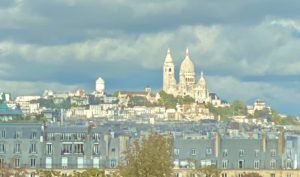
View from Musee d’Orsay

Tuileries Garden
A tourist cannot leave Paris without seeing Monet’s “Les Nympheas” at the Musee l’Orangerie. The two oval rooms, each with four paintings depicting dawn and dusk colors are monumental, so engrossing that it’s hard to leave. The permanent collection has paintings by many of the well-known impressionist artists.
Theater
Glancing through reviews of shows when I arrived in London, the pickings were unusually slim for my interests. Nevertheless, the National Theater is usually reliable. Its production of “Hansard” was polished, with super acting, had a bit of everything in it—comedy, misogyny, class, racism, and tragedy. I was happy to snag a stalls ticket for “Hamilton” for GBP 100 instead of hundreds of dollars in the US, but the production was disappointing. Except for George III, the actors’ diction was not clear and difficult to follow, especially as the play moved speedily. “Either”, an experimental play at the neighborhood Hampstead Theater explored expectations, gender roles and sexuality in a gimmicky way, but it was thought provoking.
Food
I was eagerly looking forward to the culinary delights of France as I have had some of the best meals of my life there. Boy was I disappointed. Tempted by reputation, I dined at Le Procope in the Left Bank, founded in 1686, the oldest restaurant in Paris with restored period décor and waitstaff dressed accordingly. The three-course prix fixe meal was disappointing: the vegetable soup was passable, but both the lieu (white fish) and cabbage were overdone and I needed a sharp knife to cut a piece of the tasteless pear tart. Vagenende’s late 19th Century restored décor was attractive, but the food was not. The onion soup had virtually no onions, the floating bread was not toasted, and there wasn’t a hint of sherry. The mushroom risotto was barely edible, gooey and tasteless. Bofinger, also had restored 19th Century décor and is known for its Alsatian cuisine. The oysters had a delicate vanilla taste, but the seafood was overcooked and the choucroute, the house specialty, supposed to be freshly harvested, crisp, with an acidic taste, was tepid, limp and tasteless, as if it came out of a can and barely heated.
My opinion of these restaurants was corroborated by the Gayot restaurant reviews that gave their lowest grade to Le Procope and second lowest to the other two. I should have looked for these reviews before going to the restaurants. When I got back to London and talked of my culinary experience in Paris, I was told that it’s a well-known that French food has remained static, not kept up with developments, and is now mediocre. Indeed, people said, they eat better in London than in Paris. Who would have thought!
 The best meals I had in Paris were at Mimi Ramen and Aux Delices du Liban. The vegetable Ramen had mushrooms, bamboo, spring onions and chives in a broth of rice wine, merin (a light version of sake), soy sauce with a plentiful serving of noodles. Ingredients melded well, the bamboo was crisp and shitake mushrooms meaty. At Liban I had the Mezze plate: the hummus and babaganoush were creamy and dense and falafel were crisp on the outside and warm and soft on the inside, the dolmas and spinach pie could have been better. The fruit plate with watermelon, pineapples and oranges at the end was refreshing.
The best meals I had in Paris were at Mimi Ramen and Aux Delices du Liban. The vegetable Ramen had mushrooms, bamboo, spring onions and chives in a broth of rice wine, merin (a light version of sake), soy sauce with a plentiful serving of noodles. Ingredients melded well, the bamboo was crisp and shitake mushrooms meaty. At Liban I had the Mezze plate: the hummus and babaganoush were creamy and dense and falafel were crisp on the outside and warm and soft on the inside, the dolmas and spinach pie could have been better. The fruit plate with watermelon, pineapples and oranges at the end was refreshing.
As I don’t think of London as a culinary destination, I am rarely disappointed. On average though, my meals were definitely better than in Paris. I had eaten at Lure Fish Kitchen and Anima e Cuore on previous visits. On this trip, my first visit to Lure was satisfying. I had the fried beer battered cod and shared crushed minted garden peas and triple cooked fries with friends. The batter was crisp, but the fish remained moist; the mint added to taste of fresh peas; and, although I prefer thin fries, the larger chips with the soft inside were fine. My second visit was disappointing. The cornish plaice goujons was overcooked, making it mushy and I got a mountain of skinny fries, which were fine, but too much and the restaurant was not flexible in combining them with a half order of peas for a single diner. The return to Anima was not disappointing, especially as it was spiffed up, now two adjoining holes in the wall with modern furnishings. I usually order their outstanding fresh seafood pasta, but to make a change I asked for a vegetarian version, which was fine, but not as flavorful or plentiful as the seafood. My friends’ unadventurous approach of sticking with the known dish paid off.
Silveryberry Café was a new find where I had two good brunches: free range poached eggs florentine on spinach and kale with chili on thick hollandaise, all on toasted sourdough; and scottish smoked salmon on rye topped with poached eggs with kale pesto and sun-dried tomatoes, all good, except the kale pesto was not memorable. The unusual find was Pret-a-Manger where the soup, sandwiches (especially the free-range eggs with mayo and salmon with cheese on whole wheat bread) and flat white coffee were unexpectedly good and became my go-to for a quick, wholesome meal, especially in Paris, but also in London.
Lodging
I tried Airbnb for the first time in London. For my first week, the small one-bedroom top-floor flat in Belsize Park was in a good location, but it was overpriced for what it offered. The ceilings were slanted, creating a claustrophobic feel and the sink was not functional for a couple of days. For the second week, the flat was near an entrance to Hampstead Heath–it was modern and everything worked, and cheaper than the first flat. I would go back there again. In Paris I stayed in a friend’s pied a terre in the university district near the Pantheon. The location was terrific for getting around, eating and shopping for food.


